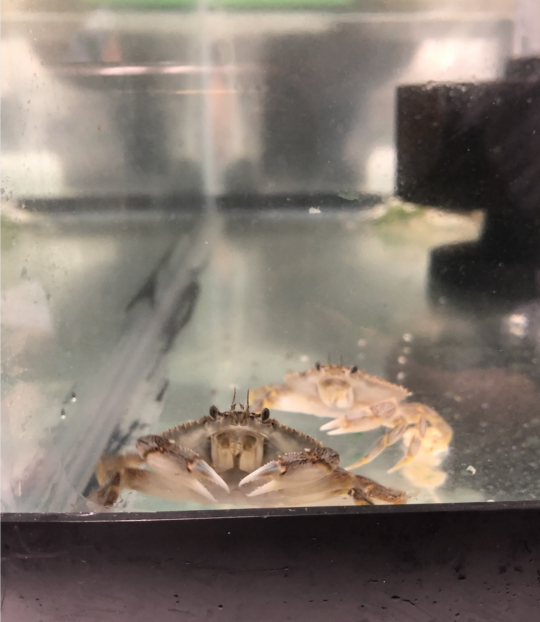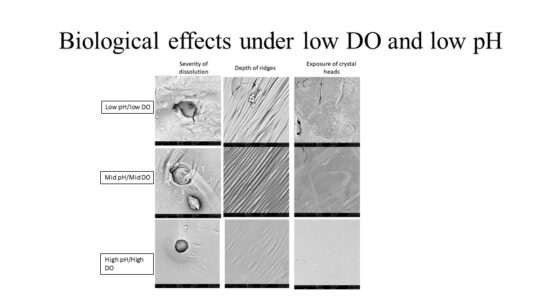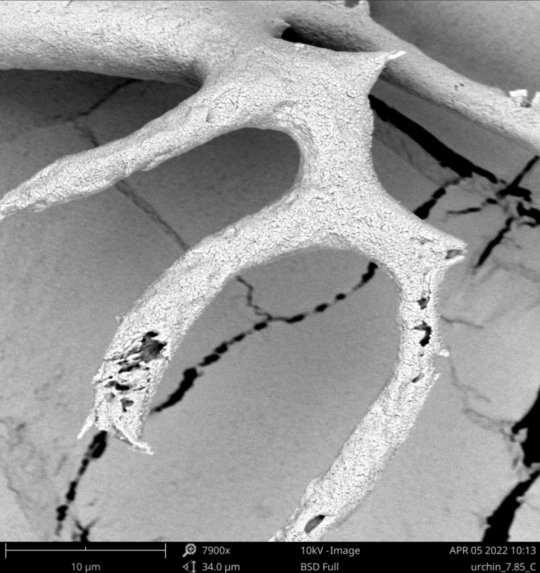Red sea urchins suffer harmful growth effects under common California water conditions
Conditions along the California coast are changing quickly, with ocean acidification (OA) and hypoxia of increasing concern, particularly for ecologically and commercially important calcifying species such as red sea urchins and Dungeness crabs. It is critical to understand species-specific tolerance thresholds and the interactions of co-occurring stressors to predict climate change impacts on fisheries and ecosystems and inform management. University of Southern California (USC) Sea Grant funded a study to examine the responses of larval Dungeness crabs and larval red sea urchins under interactive OA and hypoxia stressor effects to determine the overall sensitivity of these species. The study will determine those areas along the California coast that are most sensitive to the combined effects for both species.
Key Results:
- Red sea urchin larvae suffer harmful developmental effects under even relatively mild laboratory conditions of changing OAH
- In addition to this gradient, breakpoints have been detected (DO of 2.64-3.67 mg/L and pH 7.6-7.85), representing drastic shifts in response curves and a potential environmental threshold that acutely impacts gene expression and development.
- Simulated OA and hypoxia conditions that are documented to exist in CA coastal waters have shown that even mild conditions of combined OA and hypoxia have a measurable detrimental effect on the performance of red urchin larvae.
- By assessing the physiological response and gene expression of these species, the study hopes to inform future management actions to mitigate OAH-related impacts and maintain fishery populations.
Project Impacts & Application:
- Results were presented to National Oceanic and Atmospheric Administration (NOAA) leadership in two invitation-only talks as well as to the state water quality managers
Principal Investigators:
- Nina Bednarsek, Ph.D., Southern California Coastal Water Research Project
- Andrew Gracey, Ph.D., University of Southern California
Funding:
NOAA, 2020-2022
Additional Info and Publications:
- https://dornsife.usc.edu/labs/gracey/
- Bednaršek Nina, Ambrose Richard, Calosi Piero, Childers Richard K., Feely Richard A., Litvin Steven Y., Long W. Christopher, Spicer John I., Štrus Jasna, Taylor Jennifer, Kessouri Faycal, Roethler Miranda, Sutula Martha, Weisberg Stephen B. Synthesis of Thresholds of Ocean Acidification Impacts on Decapods. Front. Mar. Sci., 26 October 2021 Sec. Coastal Ocean Processes Volume 8 – 2021 | https://doi.org/10.3389/fmars.2021.651102
- Nina Bednaršek, Richard A. Feely, Marcus W. Beck, Simone R. Alin, Samantha A. Siedlecki, Piero Calosi, Emily L. Norton, Casey Saenger, Jasna Štrus, Dana Greeley, Nikolay P. Nezlin, Miranda Roethler, John I. Spicer. Exoskeleton dissolution with mechanoreceptor damage in larval Dungeness crab related to severity of present-day ocean acidification vertical gradients, Science of The Total Environment, Volume 716, 2020, 136610, ISSN 0048-9697, https://doi.org/10.1016/j.scitotenv.2020.136610.
- Norton Emily L., Siedlecki Samantha, Kaplan Isaac C., Hermann Albert J., Fisher Jennifer L., Morgan Cheryl A., Officer Suzanna, Saenger Casey, Alin Simone R., Newton Jan, Bednaršek Nina, Feely Richard A. The Importance of Environmental Exposure History in Forecasting Dungeness Crab Megalopae Occurrence Using J-SCOPE, a High-Resolution Model for the US Pacific Northwest. Frontiers in Marine Science. VOLUME 7. 2020. DOI=10.3389/fmars.2020.00102
Access our Publications Database to view publications from this project or other related topics





